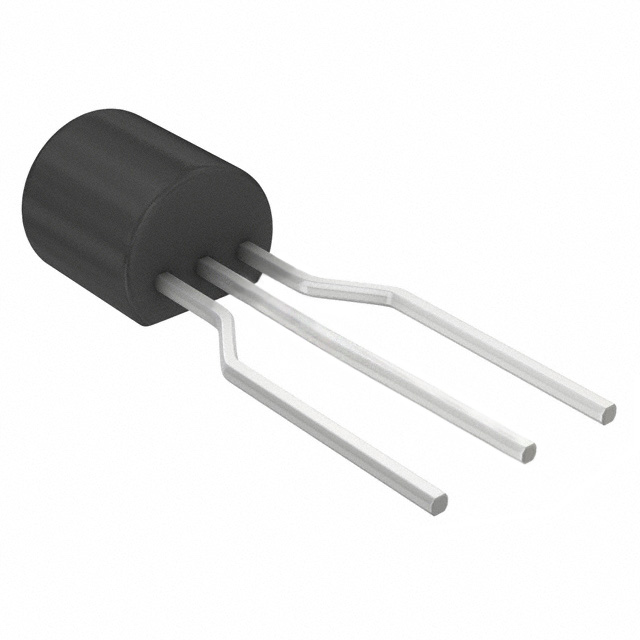BC546-AP
Product Overview
Category
The BC546-AP belongs to the category of small-signal NPN bipolar junction transistors (BJTs).
Use
It is commonly used for amplification and switching of electronic signals in various applications.
Characteristics
- Low power consumption
- High current gain
- Low noise
- Small package size
Package
The BC546-AP is typically available in a TO-92 package.
Essence
This transistor is essential for low-power amplification and signal switching in electronic circuits.
Packaging/Quantity
The BC546-AP is usually packaged in reels or tubes, with quantities varying based on manufacturer specifications.
Specifications
- Collector-Base Voltage (VCBO): 80V
- Collector-Emitter Voltage (VCEO): 65V
- Emitter-Base Voltage (VEBO): 6V
- Collector Current (IC): 100mA
- Power Dissipation (PD): 500mW
- Transition Frequency (fT): 150MHz
Detailed Pin Configuration
The BC546-AP transistor has three pins: 1. Collector (C) 2. Base (B) 3. Emitter (E)
Functional Features
- Amplification of weak electronic signals
- Switching of electronic circuits
- Suitable for low-power applications
Advantages
- Low power consumption
- High current gain
- Low noise performance
Disadvantages
- Limited collector current compared to other high-power transistors
- Relatively lower voltage ratings
Working Principles
The BC546-AP operates as a current-controlled switch or amplifier. When a small current flows into the base terminal, it controls a much larger current between the collector and emitter terminals, allowing for signal amplification or switching.
Detailed Application Field Plans
The BC546-AP is widely used in the following applications: - Audio amplifiers - Signal amplification in sensor circuits - Switching circuits in electronic devices - Oscillator circuits
Detailed and Complete Alternative Models
Some alternative models to the BC546-AP include: - BC547 - 2N2222 - 2N3904 - 2N4401
In conclusion, the BC546-AP is a versatile small-signal NPN transistor with applications in various electronic circuits, offering low power consumption, high current gain, and reliable performance in low-power amplification and switching tasks.
Word Count: 311
قم بإدراج 10 أسئلة وإجابات شائعة تتعلق بتطبيق BC546-AP في الحلول التقنية
What is the BC546-AP transistor used for?
- The BC546-AP transistor is commonly used for general purpose amplification and switching applications in electronic circuits.
What are the key specifications of the BC546-AP transistor?
- The BC546-AP transistor typically has a maximum collector current of 100mA, a maximum collector-emitter voltage of 65V, and a maximum power dissipation of 500mW.
Can the BC546-AP be used as a switch?
- Yes, the BC546-AP can be used as a switch in low-power applications due to its ability to control larger currents and voltages with a small input signal.
How do I identify the pin configuration of the BC546-AP transistor?
- The pinout of the BC546-AP transistor is typically Emitter (E), Base (B), and Collector (C) when viewing the flat side with the leads facing downward.
What are some common circuit configurations using the BC546-AP transistor?
- Common circuit configurations include common emitter amplifiers, switch circuits, and oscillator circuits.
What are the typical operating conditions for the BC546-AP transistor?
- The BC546-AP transistor is typically operated within a temperature range of -55°C to 150°C and at a maximum collector current of 100mA.
Can the BC546-AP be used in audio amplifier circuits?
- Yes, the BC546-AP can be used in low-power audio amplifier circuits, especially for small signal amplification.
What are some alternative transistors to the BC546-AP?
- Alternative transistors that can be used in place of the BC546-AP include the BC547, BC548, and 2N2222.
Are there any special considerations for driving inductive loads with the BC546-AP?
- When driving inductive loads, it's important to use a flyback diode to protect the transistor from voltage spikes generated by the inductive load.
Where can I find detailed application notes for using the BC546-AP in technical solutions?
- Detailed application notes for using the BC546-AP can be found in the manufacturer's datasheet, as well as in various electronics textbooks and online resources.


